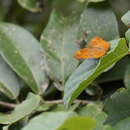pt-BR
nomes no trilho de navegação


Rohana parisatis (Syn.: Apatura parisatis) ist ein in Asien vorkommender Schmetterling (Tagfalter) aus der Familie der Edelfalter (Nymphalidae) in der Unterfamilie der Schillerfalter (Apaturinae).
Die Flügelspannweite der Falter beträgt 50 bis 55 mm. Die Art zeigt einen deutlichen Sexualdimorphismus. Bei den Männchen ist die Flügeloberseite schwarzbraun, lediglich einige sehr kleine weiße Flecke heben sich nahe am Apex der Vorderflügel ab. Bei den Weibchen dominieren in der Submarginal- und Postdiskalregion gelbbraune sowie in der Diskal- und Basalregion rotbraune Farben. Die Flügelunterseiten sind bei den Männchen rotbraun marmoriert, im Randbereich aufgehellt, bei den Weibchen ähnlich gezeichnet, jedoch gelbbraun gefärbt.
Die Raupen sind grün gefärbt und haben eine sehr breite gelbe Rückenlinie, die auf jedem Segment einen großen blaugrünen Fleck zeigt. Auffällig sind ihre zwei schwarzen Geweih-ähnlichen Kopfhörner sowie ein in einer Doppelspitze auslaufendes Körperende.
Die leicht gebogene Puppe zeigt mittig eine höckerartige Erhebung. Sie ist anfangs grün gefärbt und wird als Stürzpuppe mit einer Gespinstverankerung an Zweigen, Stämmen oder Blättern angeheftet. Kurz vor dem Schlüpfen der Falter scheinen deren Farben durch die Puppenhülle.
Die Art kommt in Indien, Sri Lanka, Thailand, Malaysia, Indonesien, Myanmar, Vietnam und im Süden Chinas vor. In den verschiedenen Vorkommensgebieten werden derzeit zehn Unterarten klassifiziert.[1] Rohana parisatis besiedelt in erster Linie feuchte Laubwälder, bevorzugt in Höhenlagen zwischen 200 und 800 Metern.[2] Auf Sri Lanka wurde die Art noch in 1800 Metern Höhe nachgewiesen.[3]
Die Falter fliegen in aufeinander folgenden Generationen. Sie halten sich gerne in höher gelegenen Baumregionen auf. Während die Weibchen zuweilen Blüten besuchen, saugen die Männchen am Boden an Kot oder feuchten Erdstellen, um Flüssigkeiten sowie Mineralstoffe aufzunehmen.[4] Die Raupen ernähren sich bevorzugt von den Blättern von Zürgelbaumarten (Celtis), beispielsweise von Celtis tetranda oder Celtis lycodoxylon.
Rohana parisatis ist in den meisten seiner Verbreitungsgebiete nicht selten und wird demzufolge von der Weltnaturschutzorganisation IUCN als „Least Concern = nicht gefährdet“ eingestuft.[5]
Rohana parisatis (Syn.: Apatura parisatis) ist ein in Asien vorkommender Schmetterling (Tagfalter) aus der Familie der Edelfalter (Nymphalidae) in der Unterfamilie der Schillerfalter (Apaturinae).
Rohana parisatis, the black prince, is a species of butterfly of the family Nymphalidae found in Indomalayan realm.[1][2]
Male upperside deep velvety black, with one minute snow-white preapical spot on the forewing; the cilia of both forewing and hindwing alternately black and white. Underside dark purplish brown, shaded at base of wings and along costal margin and apex of forewing with dark ferruginous; both forewing and hindwing with two black spots in the discoidal area, followed by an auriform mark and an irregular median band, crossing both wings, of dark brown, markings outwardly obscurely and interruptedly bordered with lilacine; beyond the discal area both wings are shaded transversely with dark brown, succeeded by a subterminal dark line bordered inwardly with purple; forewing with the white preapical spot larger; hindwing with a black white-centred minute subtornal spot. Antennae black; head, thorax and abdomen velvety black, dark brown beneath.[3]
Female upperside yellowish brown. Forewings and hindwings: basal half shaded and marked with brown, with an angulated transverse broad brown median fascia and a postdiscal transverse brown shading; on the hindwing traversed by a series of obscure dark spots; on the hindwing traversed by a series of obscure dark spots; on the forewing with three, sometimes four, minute subapical white spots; a transverse series of dark lunular markings on both wings, followed by a subterminal dark line. Underside yellowish brown; markings somewhat similar to those in the male, but more clearly defined. Antennae head, thorax and abdomen light brown, yellowish beneath.[3]
Race camiba, Moore of southern India and Sri Lanka, is absolutely identical except for the constant minute difference of the forewing on the upper and undersides; this has in the male three, in the female five subapical white dots.[3][4]
Rohana parisatis, the black prince, is a species of butterfly of the family Nymphalidae found in Indomalayan realm.
Apatura parisatis is een vlinder uit de familie van de Nymphalidae.[1] De wetenschappelijke naam van de soort is voor het eerst geldig gepubliceerd in 1850 door John Obadiah Westwood.
Bronnen, noten en/of referenties